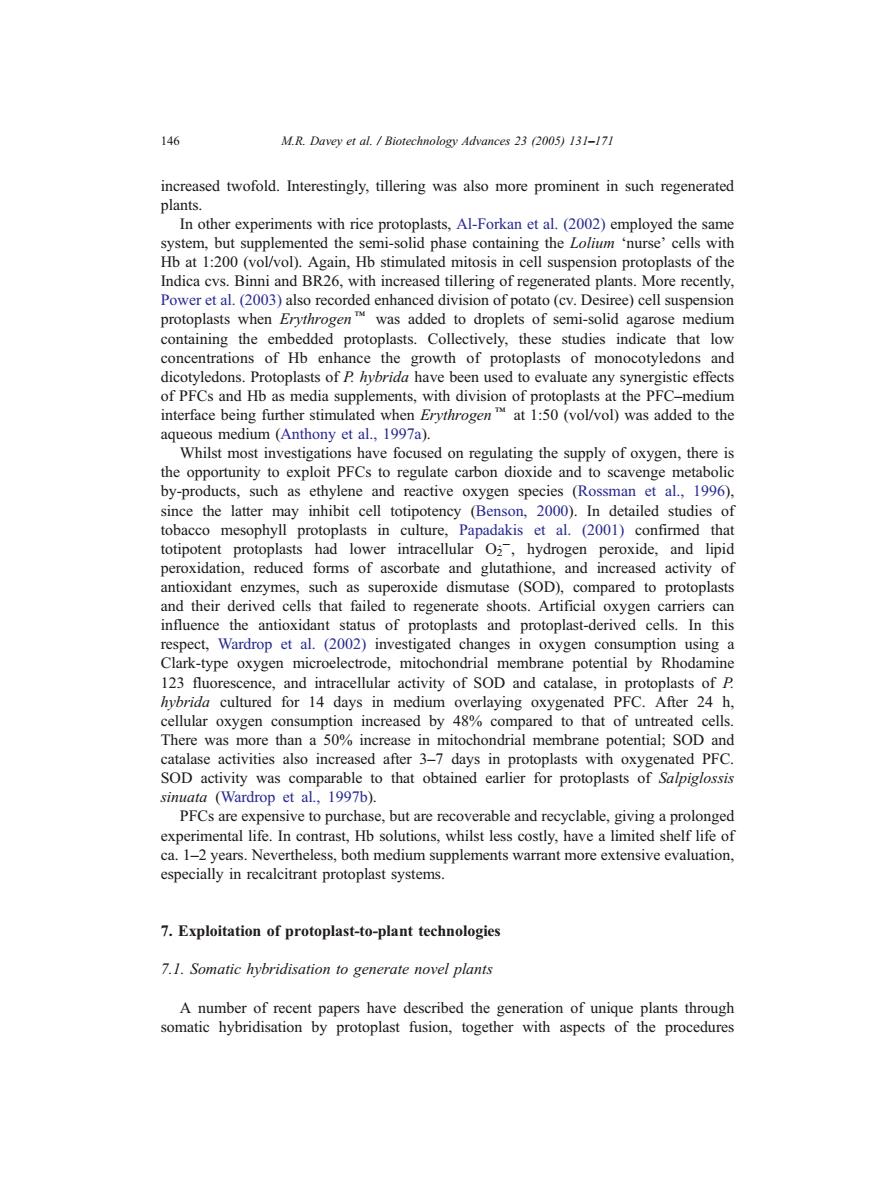正在加载图片...

146 M.R.Davey et al.Biotechnology Advances 23 (2005)131-171 increased twofold.Interestingly,tillering was also more prominent in such regenerated plants. In other experiments with rice protoplasts,Al-Forkan et al.(2002)employed the same system,but supplemented the semi-solid phase containing the Lolium 'nurse'cells with Hb at 1:200(vol/vol).Again,Hb stimulated mitosis in cell suspension protoplasts of the Indica cvs.Binni and BR26,with increased tillering of regenerated plants.More recently, Power et al.(2003)also recorded enhanced division of potato(cv.Desiree)cell suspension protoplasts when Erythrogen was added to droplets of semi-solid agarose medium containing the embedded protoplasts.Collectively,these studies indicate that low concentrations of Hb enhance the growth of protoplasts of monocotyledons and dicotyledons.Protoplasts of P hybrida have been used to evaluate any synergistic effects of PFCs and Hb as media supplements,with division of protoplasts at the PFC-medium interface being further stimulated when Erythrogen at 1:50(vol/vol)was added to the aqueous medium (Anthony et al.,1997a). Whilst most investigations have focused on regulating the supply of oxygen,there is the opportunity to exploit PFCs to regulate carbon dioxide and to scavenge metabolic by-products,such as ethylene and reactive oxygen species (Rossman et al.,1996), since the latter may inhibit cell totipotency (Benson,2000).In detailed studies of tobacco mesophyll protoplasts in culture,Papadakis et al.(2001)confirmed that totipotent protoplasts had lower intracellular O,hydrogen peroxide,and lipid peroxidation,reduced forms of ascorbate and glutathione,and increased activity of antioxidant enzymes,such as superoxide dismutase (SOD),compared to protoplasts and their derived cells that failed to regenerate shoots.Artificial oxygen carriers can influence the antioxidant status of protoplasts and protoplast-derived cells.In this respect,Wardrop et al.(2002)investigated changes in oxygen consumption using a Clark-type oxygen microelectrode,mitochondrial membrane potential by Rhodamine 123 fluorescence,and intracellular activity of SOD and catalase,in protoplasts of P hybrida cultured for 14 days in medium overlaying oxygenated PFC.After 24 h, cellular oxygen consumption increased by 48%compared to that of untreated cells. There was more than a 50%increase in mitochondrial membrane potential;SOD and catalase activities also increased after 3-7 days in protoplasts with oxygenated PFC. SOD activity was comparable to that obtained earlier for protoplasts of Salpiglossis sinuata (Wardrop et al.,1997b). PFCs are expensive to purchase,but are recoverable and recyclable,giving a prolonged experimental life.In contrast,Hb solutions,whilst less costly,have a limited shelf life of ca.1-2 years.Nevertheless,both medium supplements warrant more extensive evaluation, especially in recalcitrant protoplast systems. 7.Exploitation of protoplast-to-plant technologies 7.1.Somatic hybridisation to generate novel plants A number of recent papers have described the generation of unique plants through somatic hybridisation by protoplast fusion,together with aspects of the proceduresincreased twofold. Interestingly, tillering was also more prominent in such regenerated plants. In other experiments with rice protoplasts, Al-Forkan et al. (2002) employed the same system, but supplemented the semi-solid phase containing the Lolium dnurseT cells with Hb at 1:200 (vol/vol). Again, Hb stimulated mitosis in cell suspension protoplasts of the Indica cvs. Binni and BR26, with increased tillering of regenerated plants. More recently, Power et al. (2003) also recorded enhanced division of potato (cv. Desiree) cell suspension protoplasts when Erythrogenk was added to droplets of semi-solid agarose medium containing the embedded protoplasts. Collectively, these studies indicate that low concentrations of Hb enhance the growth of protoplasts of monocotyledons and dicotyledons. Protoplasts of P. hybrida have been used to evaluate any synergistic effects of PFCs and Hb as media supplements, with division of protoplasts at the PFC–medium interface being further stimulated when Erythrogenk at 1:50 (vol/vol) was added to the aqueous medium (Anthony et al., 1997a). Whilst most investigations have focused on regulating the supply of oxygen, there is the opportunity to exploit PFCs to regulate carbon dioxide and to scavenge metabolic by-products, such as ethylene and reactive oxygen species (Rossman et al., 1996), since the latter may inhibit cell totipotency (Benson, 2000). In detailed studies of tobacco mesophyll protoplasts in culture, Papadakis et al. (2001) confirmed that totipotent protoplasts had lower intracellular O2 S, hydrogen peroxide, and lipid peroxidation, reduced forms of ascorbate and glutathione, and increased activity of antioxidant enzymes, such as superoxide dismutase (SOD), compared to protoplasts and their derived cells that failed to regenerate shoots. Artificial oxygen carriers can influence the antioxidant status of protoplasts and protoplast-derived cells. In this respect, Wardrop et al. (2002) investigated changes in oxygen consumption using a Clark-type oxygen microelectrode, mitochondrial membrane potential by Rhodamine 123 fluorescence, and intracellular activity of SOD and catalase, in protoplasts of P. hybrida cultured for 14 days in medium overlaying oxygenated PFC. After 24 h, cellular oxygen consumption increased by 48% compared to that of untreated cells. There was more than a 50% increase in mitochondrial membrane potential; SOD and catalase activities also increased after 3–7 days in protoplasts with oxygenated PFC. SOD activity was comparable to that obtained earlier for protoplasts of Salpiglossis sinuata (Wardrop et al., 1997b). PFCs are expensive to purchase, but are recoverable and recyclable, giving a prolonged experimental life. In contrast, Hb solutions, whilst less costly, have a limited shelf life of ca. 1–2 years. Nevertheless, both medium supplements warrant more extensive evaluation, especially in recalcitrant protoplast systems. 7. Exploitation of protoplast-to-plant technologies 7.1. Somatic hybridisation to generate novel plants A number of recent papers have described the generation of unique plants through somatic hybridisation by protoplast fusion, together with aspects of the procedures 146 M.R. Davey et al. / Biotechnology Advances 23 (2005) 131–171�